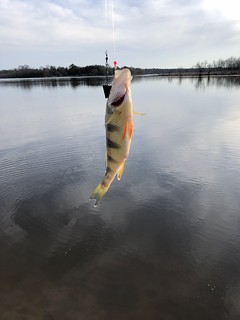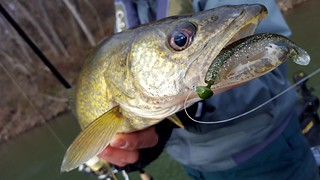Weekly Fishing Report: March 14
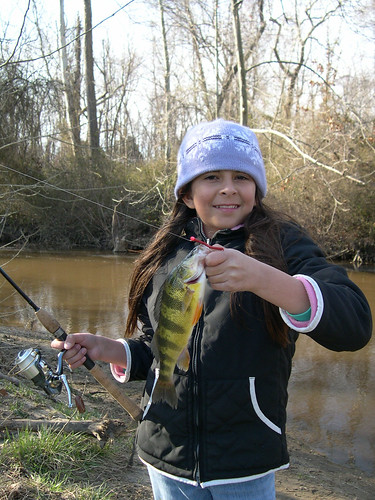
This happy girl was lucky enough to get out with her dad for a little yellow perch fishing. Photo by Rich Watts
We are less than a week from the official first day of spring, and the recent switch to daylight saving time gives us an extra hour of daylight to enjoy some fishing after school or work. Daffodils are blooming and so are the fishing prospects.
There is plenty of fun trout fishing to be had, and your favorite fishing hole has a variety of freshwater fish that are raising up their activity levels after a cold winter. There is still good fishing for post-spawn yellow perch and the white perch runs will start soon.
Before we get into this week’s fishing report, I wanted to remind everyone that they can submit their own fishing reports and photos to the Maryland Angler’s Log. To post a report, please email your name, hometown, photos, location information and additional content for your report. All information is optional, but encouraged. New reports are posted daily during the busy fishing seasons.
In the upper bay region, the water flows through the Conowingo Dam have become more moderate this week and water clarity has greatly improved. The water temperature in the lower Susquehanna River remains a chilly 35 degrees and there has been much talk about the pile of floating debris backed up behind the dam. If we have a large amount of water come down from Pennsylvania and overflow gates are opened, this material could cause navigation hazards in the upper bay region.
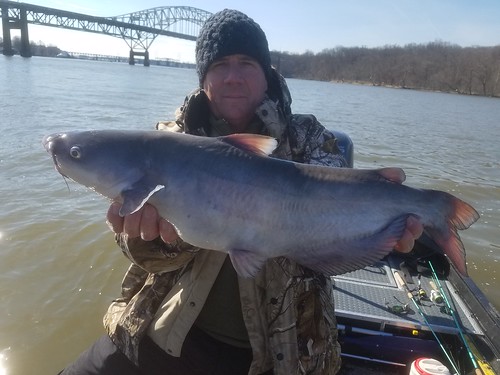
Eric Lacock holds up a big blue catfish he caught recently on the lower Susquehanna River. Photo courtesy of Eric Lacock
Besides holding a lot of channel catfish, the Susquehanna also has flathead catfish and blue catfish. The smaller flatheads can be caught in the lower parts of the river on fresh cut bait. If a whopper — we’re talking more than 25 pounds –strikes your fancy, show up at the dam pool in waders with a sturdy surf-fishing outfit. Those in the know will get as close to the fence as possible and cast heavy swim shads or jig heads tipped with a fresh healthy sized chunk of fresh cut bait into the head of the dam pool. The large flatheads are strong enough to keep in place in the swift current and get big and fat by feeding on injured fish coming through the dam’s power generating turbines.
Large blue catfish are becoming more common in the lower Susquehanna and can also be caught on fresh cut bait.
The tidal rivers flowing into the upper bay are holding around 45 degrees this week. Most of the yellow perch have spawned now and the post-spawn perch can be found in the middle regions of the tidal rivers on hard bottom. Good tactics to catch some of these perch include fishing with minnows on a bottom rig or working a minnow on a shad dart or drop shot rig slowly along the bottom. The white perch are holding a little farther up the water courses and tend to be holding back until water temperatures climb into the mid-50s. They can be caught on shad darts, bottom rigs or slip bobber setups with grass shrimp. The Northeast River near the town of North East is traditionally one of the better places to catch yellow perch; the Chester River is another popular one. The Bush, Chester, Magothy and Patapsco rivers are popular spots to target white perch.
Anglers fishing for yellow or white perch in the tidal rivers will also encounter crappie along with a largemouth bass or chain pickerel now and then. Just about every tidal river has a healthy population of channel catfish and white catfish; they can be caught while fishing minnows or they can be targeted with cut bait.
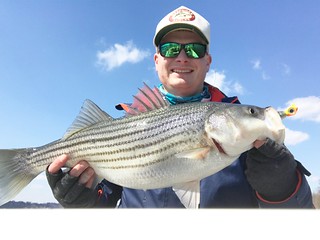
Kevin Thomas holds up a nice striped bass he caught and released recently. Photo courtesy of Kevin Thomas
There has been some striped bass catch-and-release action in the upper bay this week. School-sized striped bass can be found at some of the warm water discharge plumes at the fossil fuel power stations in the Baltimore area. Jigging close to the bottom tends to be the best tactic. The rock piles and concrete abutments at the Bay Bridge are holding some striped bass, but with water temperatures holding around 40 degrees it is difficult to get them to take a soft plastic jig. A times they may appear stacked up on the bottom, and foul-hooking one by accident is not uncommon. The water temperature will need to elevate another 10 degrees before these school-sized fish become more active.
The striped bass catch-and-release action in the middle bay region tends to focus on jigging at the Calvert Cliffs Nuclear Power Plant’s warm water discharge this week. The large female striped bass are making their way up the bay and entering the spawning rivers. At times when they feel that warm water, they nose into their version of a hot tub and bask in the warm water for a spell. Jigging on the bottom with large soft plastic jigs or butterfly jigs while drifting in the discharge current is a proven tactic. These big fish need to be supported horizontally with care and speed for getting their pictures taken, and they should not be out of the water any longer than you can hold your breath. Releases are best done while the fish is in the water.
There are smaller striped bass spread throughout the middle bay region along channel edges and similar structure. Many are either holding to structure such as channel edges in the bay as others are on the move heading up the bay toward the upper bay spawning sites or rivers. When anglers can spot them on a depth finder, jigging with soft plastics can offer some fun catch and release fishing.
The vanguard of the male striped bass have been in the spawning reaches of the Choptank, Nanticoke, Patuxent and Potomac rivers for several weeks now; the large females are filling in and most will have arrived within the next week or so. Traditionally the largest female striped bass spawn first and may spawn as early as the last week of March. Water temperature plays a major role — most spawning starts around 59 degrees but some of the large females may start to spawn in the low to mid-50s. Catch-and-release anglers are reminded that spawning rivers have been off limits since March 1 and fines and license suspensions are in store for those who choose to ignore the rules. Kelly Greenhawk from our Fishing and Boating Services has updated the Maryland striped bass regulations map for us, and it is much easier to understand for all concerned.
Another contributor that works tirelessly to bring the best information to the fishing public is Tom Parham from the department’s Tidewater Ecosystem Assessment group. His Click Before You Cast contribution to the weekly fishing reports offers water quality insight for fishermen. Parameters such as temperature, salinity and oxygen are important to knowing where fish can best survive and be found.
Tom and his team report that as we approach the vernal equinox Tuesday, expect an unstable weather pattern for the next week. Windy conditions are expected from Tuesday evening through Thursday, with partly sunny skies through Sunday. These typical March conditions will continue to warm the Chesapeake Bay for gamefish that are preparing to spawn in Maryland waters in the upcoming weeks.
The Maryland portion of the bay continues to have suitable oxygen conditions from surface to bottom. In addition, there are slightly warmer surface water temperatures so anglers may want to scan these shallower areas for fish.
As reported from National Oceanic and Atmospheric Administration buoys, main bay surface water temperatures are holding at 41 degrees at both the Annapolis and Gooses Reef buoys. However, smaller streams will warm faster and will often hold water temperatures in the upper 40s. Expect reduced water clarity in portions of the larger rivers and upper Bay and also along windward shorelines. Expect normal to below normal flows for streams and rivers entering Maryland’s portion of the bay. There will be above average tidal currents conditions through Tuesday as a result of the new moon March 17.
A full weekly fishing conditions summary and more detailed and up-to-date fishing conditions throughout the bay are available at Click Before You Cast.
Meanwhile, water temperatures in the upper reaches of the tidal rivers in the middle bay region such as the Choptank and Nanticoke rivers are holding around 45 degrees this week. Many if not all of the yellow perch have spawned in the past couple of weeks and now is a great time to target post-spawn yellow perch as they make their way back down the tidal rivers. Look for them in some of the deeper holes in the far upper parts of the rivers and on deeper hard bottom in the middle sections of the rivers.
I happened to get into them on the lower Tuckahoe River recently on the last hour or so of the ebbing tide. Minnows hooked through the back behind the dorsal fin on a one-hook bottom rig was the ticket for a catch of nice post-spawn yellow perch. One tip was to make sure to use a three-way swivel to lessen line twist of the line going to the hook.
A few weeks ago the water temperatures in the spawning areas of the tidal rivers were a bit warmer and many noticed large white perch mixed in with the spawning yellow perch. Water temperatures have dropped enough that the white perch are holding back in deeper areas until water temperatures climb into the lower 50s again. It might take some exploring but they should be found holding in some of the deeper areas. Grass shrimp or bloodworms on a bottom rig should be a good way to entice them to bite.
The lower bay region has been offering some catch and release striped bass action along main channel edges in the bay and especially in the Potomac River. Striped bass are moving up the Potomac River, which is open to catch-and-release fishing. Soft plastic jigs worked close to the bottom along channel edges tend to be one of the most popular ways to fish for medium-sized fish. Angling for blue catfish in the tidal Potomac is very good this time of the year and the Fort Washington area tends to be the center of this fishery when it comes to large blue cats.
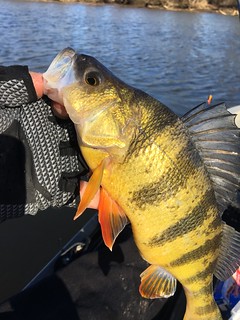
Eric Packard was fishing in the upper Patuxent near Wayson’s Corner when he caught this nice yellow perch recently. Photo by Eric Packard
Much of the focus this week is on the yellow perch and white perch spawning runs that are occurring in the region. The Nanticoke, Wicomico, Patuxent rivers and the many tributaries to the Potomac have been providing good fishing for yellow perch in the last couple of weeks and white perch are staged to begin their run. Post-spawn yellow perch are being caught in sections of the rivers and tributaries below the spawning reaches this week. Small minnows on bottom or slip bobber rigs are a good way to fish as well as lip hooked minnows on shad darts or by casting small spinners. White perch can be found a little farther downstream holding in some of the deeper holes. Placing grass shrimp or bloodworms on a bottom rig is one of the better ways to catch them.
Stocking of trout continues in many areas this week and anglers should take note that the closure 1 areas are now closed through March 31, the day many put-and-take trout fishermen refer to as opening day. Thousands of anglers from young to old will be out for this one. Until then, there are many areas designated as closures 0 and 2 that can still be fished this week. Our trout stocking website can direct you to stocking schedules, maps and regulations.
The upper Potomac River is in excellent shape this week and offers wonderful fishing for a mix of walleye and smallmouth bass. Walleye love cold water and the river is certainly running cold enough to their liking this week. From Jan. 1 until April 15, walleye over 20 inches in length need to be released to protect the breeding population. Walleye between 15 inches and 20 inches may be kept.
Fishing for largemouth bass is steadily improving as water temperature slowly warm and fish are becoming more active. Most are still holding rather deep along channel edges, structure and drop-offs. Working soft plastics such as craws, grubs and stick worms close to the bottom and very slow can entice them to pick up a bait. In small ponds and lakes the water can be slightly warmer, especially on sunny days and on the windward side of the lake or pond. The afternoon sun and wind moves warmer water to one side of a pond or lake, producing slightly warmer water that is more comfortable to largemouth bass, crappie, chain pickerel and sunfish. Small ponds are a great place to target this time of the year for this reason.
In the Ocean City area about the only show in town is fishing for tautog around the inshore and offshore wreck and reef sites. Captains on the charter and head boats have to adjust schedules based on weather and wind conditions and they even warn that catches can be based on water temperature fluctuations. Sea bass will be off limits until at least May 5 and regulators are still working on that one. On calm days some boats have also been heading offshore to the canyon edges to deep drop fish for tilefish.
“A fish, which you can’t see, deep down in the water, is a kind of symbol of peace on earth, good will to yourself. Fishing gives a man some time to think. It gives him some time to collect his thoughts and rearrange them kind of neat, in an orderly fashion.” – Robert Ruark, The Old Man and the Boy
 ABOUT THE AUTHOR Keith Lockwood has been writing the Fishing Report since 2003 and has had a long career as a fisheries research biologist since 1973. Over the course of his career he has studied estuarine fishery populations, ocean species, and over a decade long study of bioaccumulation of chemicals in aquatic species in New Jersey. Upon moving to Oxford on the eastern shore of Maryland; research endeavors focused on a variety of catch and release studies as well as other fisheries related research at the Cooperative Oxford Laboratory. Education and outreach to the fishing public has always been an important component to the mission of these studies. Keith is an avid outdoorsman enjoying hunting, fishing, bird dogs, family and life on the eastern shore of Maryland.
ABOUT THE AUTHOR Keith Lockwood has been writing the Fishing Report since 2003 and has had a long career as a fisheries research biologist since 1973. Over the course of his career he has studied estuarine fishery populations, ocean species, and over a decade long study of bioaccumulation of chemicals in aquatic species in New Jersey. Upon moving to Oxford on the eastern shore of Maryland; research endeavors focused on a variety of catch and release studies as well as other fisheries related research at the Cooperative Oxford Laboratory. Education and outreach to the fishing public has always been an important component to the mission of these studies. Keith is an avid outdoorsman enjoying hunting, fishing, bird dogs, family and life on the eastern shore of Maryland.
Sign up for the Weekly Fishing Report to be sent right to your inbox!

